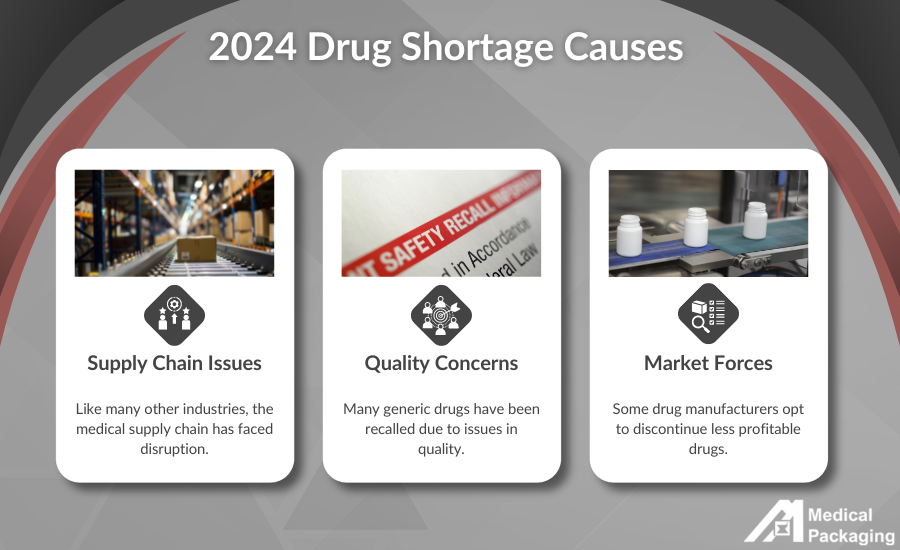Breaking Down the Drug Shortages of 2024
The landscape of healthcare in the United States often feels as intricate and complicated as the human body itself. In recent times, one of the greatest challenges stirring concern among professionals and patients alike has been the drug shortages of 2024. These shortages have broad-reaching implications, affecting everything from the supply chain management of pharmaceuticals to the availability of lifesaving, critical drugs for patients in need.
Drug shortages can sound somewhat of a vague issue until we consider the direct and often critical impact on patient’s lives. From vital chemotherapy drugs for cancer patients to essential medications for hyperactivity disorder, the landscape of drug availability has shifted dramatically in 2024, sparking widespread concern and calls for swift action.
For updated information on the drug shortage crisis, including the reason for the shortage, availability of products, and estimation of resupply, view the ASHP list or the FDA database.
Causes of the Drug Shortages in 2024
At first glance, the shortage of prescription drugs may be challenging to understand. After all, why would a country as powerful as the United States struggle with such a basic need? The answer, unfortunately, is not straightforward but is intertwined with a network of intricate factors involving not only the production and distribution of drugs but also economic, political, and regulatory elements.
Supply Chain Vulnerabilities
One major element contributing to the drug shortage crisis is the vulnerabilities in the supply chain. Often, drugs and their raw materials are sourced and processed in different countries – a complex tapestry that can be easily disrupted by a range of factors, from natural disasters affecting raw material supplies to political instabilities and even global pandemics.
The contracting practices between drug wholesalers and manufacturers, which often prioritize high-value drugs over lower-cost generic ones—those most at risk of shortage—contribute to the problem. This bias for profitability over sustainability can leave the supply of lower-cost generic drugs, essential medicines for a large fraction of the U.S. population, teetering on the edge.
Market Forces
Market forces also play a critical role. Some drug manufacturers may opt to discontinue production of less profitable drugs, leading to shortages. In an industry driven by profit margins, these decisions can have a domino effect, causing shortages that ripple across the country.
Quality Concerns for Generic Drugs
Finally, there are quality issues to consider within drug production. This aspect focuses on challenges faced by generic manufacturers. Increasing amounts of generic drugs have been recalled due to quality concerns, fueling the shortage. Alarmingly, popular medications like Lisdexamfetamine Dimesylate, a drug used to treat ADHD, have come under scrutiny, further exaggerating the crisis.
In this intricate web of causes, one thing is clear: the drug shortages of 2024 are a complex issue that requires a multifaceted approach to resolution. Understanding these causes is the first step toward finding sustainable solutions.
Implications of the Drug Shortages
As we delve into the aftermath of drug shortages, we cannot overlook the strain they place on both healthcare providers and patients. The conditions that arise from shortage situations are far-reaching and directly impact the quality of care.
An active drug shortage implies that there are limitations on what is available for patient treatment. In some situations, alternatives exist, but they may not have the same efficacy as the initially intended medication. Also, alternative drugs may come with a higher risk of side effects, putting an additional strain on the patient’s health.
Public comments and white papers have been increasingly filled with stories reflecting this crisis. Instances of parents unable to find ADHD medications for their children, or families of cancer patients scrambling to find equally effective alternatives for unavailable emergency medications like chemotherapy drugs, are becoming deeply unsettling realities of the crisis.
The response of the Federal Trade Commission, Department of Health and Human Services, and other federal agencies provides a sobering reflection of the severity of the situation. Given the complexity of these active shortages, federal bodies are grappling with formulating strategies to tackle the issue, with a focus on increasing generic drug production and bolstering the capacity of manufacturing chains.
In this light, the drug shortages of 2024 are not just numbers on spreadsheets and inventory lists. They represent a perilous reality for patients and healthcare providers across the United States. Exploring potential solutions, therefore, is not just a matter of balanced books—it is a matter of life and health.
Improving the Drug Shortage Situation
Navigating through the complexities of drug supply shortages might seem daunting at first. However, by taking systematic, strategic steps, it is possible to grapple with this issue effectively. Here are a few essential strategies being proposed to address and improve the drug shortage situation:
1. Imposing Financial Penalties
Some suggest leveraging financial penalties for delays in drug administration. This measure is believed to infuse a sense of responsibility and urgency within drug companies and discourage them from delay tactics that can exacerbate medical supplies shortage situations.
2. Enhancing Supply Chain Resilience
The essence of this strategy lies in the diversification and reinforcement of the supply chain. This can be achieved through increased domestic manufacturing capabilities and a diversified global supply chain for key drug components. It is a tall order, requiring international cooperation, but it stands as a promising recourse for buffering against supply chain disruptions.
3. Building a Robust Drug Shortage Database
The development of a comprehensive, up-to-date database on current and potential drug shortages is another crucial step towards mitigation. With access to real-time data, healthcare providers can anticipate supply issues, adjust inventories, and modify treatment plans, as necessary.
4. Overhauling Contracting Practices
There is an emerging call to reassess contracting mechanisms within the pharmaceutical industry. Some contracts prioritize high-cost drugs over lower-cost generic ones—a practice that needs to be revisited to ensure a stable supply of essential generic medications, most susceptible to shortages.
In summary, these proposed strategies represent a multi-pronged approach to tackling drug shortages—a combination of regulatory measures, strategic overhauls, and technological solutions. By adopting such an approach, it opens the possibility of mitigating future drug shortages, ensuring that essential medications remain readily available to those who need them the most.
The Role of Medical Packaging Industries in Addressing Drug Shortages
Amidst the overwhelming challenge of drug shortages, the role of companies like Medical Packaging Inc. (MPI) becomes even more critical. Facing the crisis head-on, MPI is steadfast in its commitment to proactively address, mitigate, and support medical professionals through the drug shortages.
At the heart of our efforts is a multitude of premium-quality pharmaceutical packaging and labeling systems, carefully tailored to fit the unique needs and demands of every customer. Our barcode labeling software aids in streamlining the process, enhancing safety, and reducing human error.
Our FD-Pharma® system is specifically designed to meet the needs of specialty pharmaceutical manufacturers and contract drug manufacturing organizations (CDMOs). With its ability to add FDA-compliant liquid cup packaging capabilities to manufacturing operations, MPI is contributing significantly to bolstering pharmaceutical supply chain resilience – a key factor in preventing future drug shortages.
Speed-to-Market Capabilities
MPI’s Drug Master File (DMF) – a technical document that contains information about manufacturing, processing, packaging, and storing methods – provides transparency and assures customers of our commitment to meeting regulatory requirements. Our DMF plays a pivotal role in improving speed-to-market capabilities and supporting our customers in their efforts to beat looming drug shortages.
MPI’s longstanding commitment to quality, customization, and customer support extends far beyond the management of present shortages. As we continue to innovate and expand our product line, we remain devoted to playing a significant role in the battle against drug shortages.
Our products aim to support healthcare professionals with their manufacturing, repackaging, and distribution responsibilities, especially during this time of short supply.
Contact us today for more information about our products or customer support services.
Resources
“Drug Shortages List.” ASHP, www.ashp.org/drug-shortages/current-shortages/drug-shortages-list. Accessed 10 May 2024.
“FDA Drug Shortages.” FDA Drug Shortages, www.accessdata.fda.gov/scripts/drugshortages/default.cfm. Accessed 22 May 2024.
“Lisdexamfetamine: Medlineplus Drug Information.” MedlinePlus, U.S. National Library of Medicine, medlineplus.gov/druginfo/meds/a607047.html. Accessed 11 May 2024.
“Lisdexamfetamine Dimesylate (Oral Route) Description and Brand Names.” Mayo Clinic, Mayo Foundation for Medical Education and Research, 1 Apr. 2024, www.mayoclinic.org/drugs-supplements/lisdexamfetamine-dimesylate-oral-route/description/drg-20070888.
“Attention-Deficit/Hyperactivity Disorder.” National Institute of Mental Health, U.S. Department of Health and Human Services, www.nimh.nih.gov/health/topics/attention-deficit-hyperactivity-disorder-adhd. Accessed 30 May 2024.
Contact MPI Today for Personal Assistance
MPI’s Drug Master File provides speed-to-market regulatory and technical support related to our packaging components for medical and pharmaceutical market clients